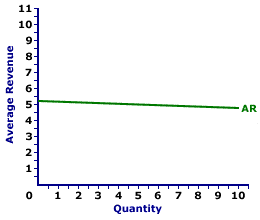
|
|
NON-COUNTERFEITABILITY: One of four characteristics that enables an asset to better function as money. The other three are durability, divisibility, and transportablity. This characteristic means that the item used as money can not be easily counterfeited, that is, duplicated by entities not authorized to do so. Money that can be easily duplicated ceases to function effectively as a medium of exchange.
Visit the GLOSS*arama
|
|


|

|
                           AVERAGE REVENUE CURVE, MONOPOLISTIC COMPETITION: A curve that graphically represents the relation between average revenue received by a monopolistically competitive firm for selling its output and the quantity of output sold. Because average revenue is essentially the price of a good, the average revenue curve is also the demand curve for a monopolistically competitive firm's output. Monopolistic competition is a market structure with a large number of relatively small firms that sell similar but not identical products. Each firm is small relative to the overall size of the market such that it has some market control, but not much. In other words, it can sell a wide range of output at a narrow range of prices. This translates into a relatively elastic demand curve. If a monopolistically competitive firm wants to sell a larger quantity, then it must lower the price.The average revenue curve reflects the degree of market control held by a firm. For a perfectly competitive firm with no market control, the average revenue curve is a horizontal line. For firms with market control, such as monopolistic competition, the average revenue curve is negatively-sloped. Average Revenue Curve,
Sandwich Style |  |
The average revenue curve for Manny Mustard is displayed in the exhibit to the right. Key to this curve is that Manny Mustard is a monopolistically competitive seller of sandwiches and thus faces a negatively-sloped demand curve. Larger quantities of output are only possible with lower prices.The vertical axis measures average revenue and the horizontal axis measures the quantity of output (number of sandwiches). Although quantity on this particular graph stops at 10 sandwiches, it could go higher. This curve indicates that if Manny Mustard sells 1 sandwich (at $5.20 per sandwich), then average revenue is $5.20 per sandwich. Alternatively, if he sells 10 sandwiches (at $4.75 per sandwich), then average revenue in is $4.75 per sandwich. For Manny Mustard the average revenue curve is also the demand curve. The curve is negatively sloped, meaning that larger quantities of output result in less average revenue. Although this average revenue curve, and preceding table of average revenue numbers, is based on the production activity of Manny Mustard, a well-known monopolistically competitive firm, they apply to any firm with market control. Monopoly and oligopoly firms that also face negatively-sloped demand curves generate comparable average revenues.

Recommended Citation:AVERAGE REVENUE CURVE, MONOPOLISTIC COMPETITION, AmosWEB Encyclonomic WEB*pedia, http://www.AmosWEB.com, AmosWEB LLC, 2000-2024. [Accessed: April 29, 2024].
Check Out These Related Terms... | | | | | | | | |
Or For A Little Background... | | | | | | | | | | | |
And For Further Study... | | | | | | | | |
Related Websites (Will Open in New Window)... | | | |
Search Again?
Back to the WEB*pedia
|



|

|
|
Before 1933, the U.S. dime was legal as payment only in transactions of $10 or less.
|

|
|
"Something in human nature causes us to start slacking off at our moment of greatest accomplishment. As you become successful, you will need a great deal of self-discipline not to lose your sense of balance, humility and commitment." -- H. Ross Perot
|

|
SOFFEX
Swiss Options and Financial Futures Exchange
|

|
|
Tell us what you think about AmosWEB. Like what you see? Have suggestions for improvements? Let us know. Click the User Feedback link.
User Feedback
|


|


